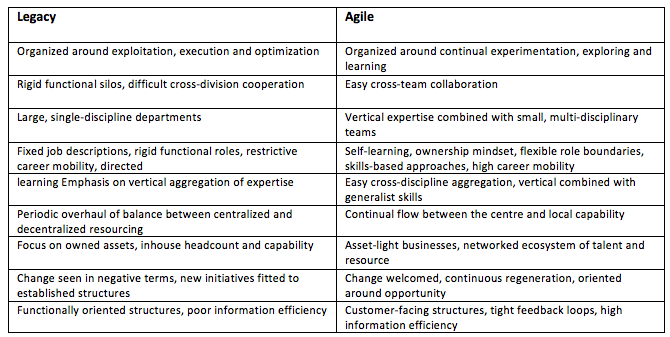This excerpt from Building the Agile Business through Digital Transformation by Neil Perkin and Peter Abraham is ©2017 and reproduced with permission from Kogan Page Ltd.

Agile structures and resourcing
The decisions we make around how we choose to build, structure and apportion our capability have a fundamental impact on our ability to deliver our strategy but also our capacity to be more agile. So what do we mean by agility in resourcing? Traditional approaches are often characterized by rigid functional or divisional silos, inflexible roles and job descriptions, a focus on owned assets and exploiting existing positions, large downsizing programmes, restrictive approaches to career mobility, demotivating performance review systems, control over resources being seen as commensurate with power and influence, and change disliked and avoided.
Our historical approaches emphasize the optimization and aggregation of vertical craft and experience expertise into functional groupings which, while valuable, comes at the expense of flexibility and effortless cross-department or division working. So in a rapidly shifting environment we need to work harder to find new and more agile ways to combine that vertical expertise, blend it with more generalist skills, and establish a far greater degree of fluidity in our resourcing.
We need easier collaboration between disciplines. Easier flow between centralized and decentralized resources. Greater internal employee mobility. A move on from rigid functional roles to a more skills-based approaches that can attract, retain and combine required skills in more adept ways. Smarter outsourcing and use of external capability to reduce reliance on owned assets. Continual modification to free up resources and refocus on new projects and initiatives.
Change welcomed as an opportunity. And as Rita Gunther McGrath described, we need key resources that are managed under central control and not held hostage by local business units, and faster, more responsive organization around opportunity rather than opportunities being squeezed into existing structures.
Greater advantage now comes from information efficiency, or establishing tight customer feedback loops, easy access to key analytics, and reducing the number of information exchanges that are needed to respond to opportunity or demand or other key processes. It is more essential than ever that our organizational structures reflect and enable progress towards our vision. Strategies that are customer-centric, for example, will struggle unless structures are adapted to also be customer focused (most, as we have already discussed, are not). Rather than supporting limited, episodic innovation and singular initiatives, resourcing needs to enable continuous experimentation and multiple projects that combine to create momentum and change.
Table 11.1 summarizes the key differences between legacy and agile.

Companies achieve great efficiencies and craft expertise through organizing in vertical functions (marketing, sales, finance, engineering, and so on). As organizations scale and become multi-product companies these vertical expertise areas exist as functions within divisions that group products together into logical areas. These multiplying silos enable functional focus and efficiency to work at scale, but faced with rapidly shifting contexts we need to be far more adept at combining functional expertise in different ways to gain advantages in velocity and focus.
We need more of our expert resource to be working concurrently with other functions, far greater emphasis on small, multi-disciplinary teams to be used to address key challenges, energize experimentation and develop new capability, and we need to greatly improved fluidity between central and localized, in-house and outsourced resourcing in order to be truly responsive and to open up new opportunity.
The principles of agile business
The Agile Manifesto gives us a blueprint for a better way of developing software, but it also speaks to some fundamental principles for doing better business in the complex adaptive environment we know today. The 12 principles of agile business align closely with those that were originated in the manifesto (Table 6.1)

~~~~
“A fantastic guide to conquering the challenges of continuous and accelerating change in today’s digital world…..a highly actionable book and a must-read for modern leadership” (Scott Brinker, Author, Hacking Marketing)
Save 20% with free P&P to the UK and US when you order the Building the Agile Business through Digital Transformation by Neil Perkins and Peter Abraham from www.koganpage.com/agilebusiness and use discount code PHRBAB20
Article by channel:
Everything you need to know about Digital Transformation
The best articles, news and events direct to your inbox
Read more articles tagged: Featured







